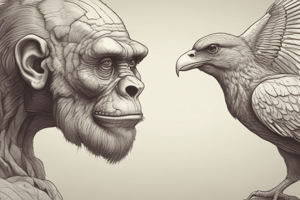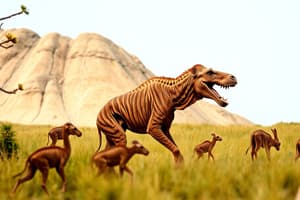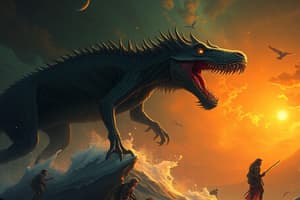Podcast
Questions and Answers
Which of the following best describes the main idea of Darwin's theory of evolution?
Which of the following best describes the main idea of Darwin's theory of evolution?
- Inherited characteristics are not influenced by environmental changes.
- Evolution is solely driven by environmental factors.
- Species evolve through natural selection and descent with modification. (correct)
- All species are static and do not change.
The phrase 'survival of the fittest' originated with Charles Darwin directly.
The phrase 'survival of the fittest' originated with Charles Darwin directly.
False (B)
What is the relationship between natural variation and natural selection?
What is the relationship between natural variation and natural selection?
Natural variation among individuals in a population allows for natural selection to occur, as some traits may provide a survival advantage.
Darwin published 'Origin of Species' in _____.
Darwin published 'Origin of Species' in _____.
Match the following terms with their definitions:
Match the following terms with their definitions:
What did Darwin observe regarding certain traits in populations?
What did Darwin observe regarding certain traits in populations?
Molecular biology contributes to our understanding of evolution by analyzing DNA similarities among species.
Molecular biology contributes to our understanding of evolution by analyzing DNA similarities among species.
Who is best known for the theory of Inheritance of Acquired Characteristics?
Who is best known for the theory of Inheritance of Acquired Characteristics?
Which of the following is NOT a type of prezygotic barrier?
Which of the following is NOT a type of prezygotic barrier?
Adaptive radiation typically occurs after mass extinction events.
Adaptive radiation typically occurs after mass extinction events.
What type of speciation occurs when populations remain in the same geographic area but split into separate gene pools?
What type of speciation occurs when populations remain in the same geographic area but split into separate gene pools?
Mechanical isolation refers to __ differences in reproductive anatomy.
Mechanical isolation refers to __ differences in reproductive anatomy.
Which prezygotic barrier is exemplified by animals that mate in different seasons?
Which prezygotic barrier is exemplified by animals that mate in different seasons?
Match the terms with their definitions:
Match the terms with their definitions:
What is the outcome of hybrid sterility?
What is the outcome of hybrid sterility?
Divergent evolution involves species becoming more similar over time.
Divergent evolution involves species becoming more similar over time.
What is a key mechanism that distinguishes artificial selection from natural selection?
What is a key mechanism that distinguishes artificial selection from natural selection?
Microevolution refers to large scale evolutionary changes in populations.
Microevolution refers to large scale evolutionary changes in populations.
What is a gene pool?
What is a gene pool?
A population in Hardy-Weinberg equilibrium shows __________ in its gene pool.
A population in Hardy-Weinberg equilibrium shows __________ in its gene pool.
Match the type of natural selection with its description:
Match the type of natural selection with its description:
Which factor is NOT a mechanism of microevolution?
Which factor is NOT a mechanism of microevolution?
Genetic drift has a stronger effect on larger populations.
Genetic drift has a stronger effect on larger populations.
What is the founder effect?
What is the founder effect?
In the theory of speciation, a species is defined as a population that can __________ in nature and produce viable, fertile offspring.
In the theory of speciation, a species is defined as a population that can __________ in nature and produce viable, fertile offspring.
Which type of selection results in two distinct phenotypes being favored?
Which type of selection results in two distinct phenotypes being favored?
Gene flow between populations decreases genetic variation.
Gene flow between populations decreases genetic variation.
What is the outcome of stabilizing selection?
What is the outcome of stabilizing selection?
The Hardy-Weinberg equilibrium provides a baseline for determining __________ in a population.
The Hardy-Weinberg equilibrium provides a baseline for determining __________ in a population.
What does sexual selection primarily focus on?
What does sexual selection primarily focus on?
Match the point of origin for genetic drift phenomena:
Match the point of origin for genetic drift phenomena:
Flashcards
Natural Selection
Natural Selection
Process where organisms with traits better suited to their environment are more likely to survive and reproduce.
Descent with modification
Descent with modification
All species are descended from previous ancestral species, changing over time.
Homologous structures
Homologous structures
Similar structures shared by species with a common ancestor, but may have different functions.
Analogous structures
Analogous structures
Signup and view all the flashcards
Vestigial features
Vestigial features
Signup and view all the flashcards
Fossil Record
Fossil Record
Signup and view all the flashcards
Struggle for existence
Struggle for existence
Signup and view all the flashcards
Fitness
Fitness
Signup and view all the flashcards
Prezygotic Barriers
Prezygotic Barriers
Signup and view all the flashcards
Postzygotic Barriers
Postzygotic Barriers
Signup and view all the flashcards
Behavioral Isolation
Behavioral Isolation
Signup and view all the flashcards
Habitat Isolation
Habitat Isolation
Signup and view all the flashcards
Temporal Isolation
Temporal Isolation
Signup and view all the flashcards
Mechanical Isolation
Mechanical Isolation
Signup and view all the flashcards
Gametic Isolation
Gametic Isolation
Signup and view all the flashcards
Sympatric Speciation
Sympatric Speciation
Signup and view all the flashcards
Artificial Selection
Artificial Selection
Signup and view all the flashcards
Natural Selection vs. Artificial Selection
Natural Selection vs. Artificial Selection
Signup and view all the flashcards
Hardy-Weinberg Equilibrium
Hardy-Weinberg Equilibrium
Signup and view all the flashcards
Microevolution
Microevolution
Signup and view all the flashcards
Gene Pool
Gene Pool
Signup and view all the flashcards
Mutation
Mutation
Signup and view all the flashcards
Migration (Gene Flow)
Migration (Gene Flow)
Signup and view all the flashcards
Genetic Drift
Genetic Drift
Signup and view all the flashcards
Bottleneck Effect
Bottleneck Effect
Signup and view all the flashcards
Founder Effect
Founder Effect
Signup and view all the flashcards
Stabilizing Selection
Stabilizing Selection
Signup and view all the flashcards
Directional Selection
Directional Selection
Signup and view all the flashcards
Disruptive Selection
Disruptive Selection
Signup and view all the flashcards
Sexual Selection
Sexual Selection
Signup and view all the flashcards
Speciation
Speciation
Signup and view all the flashcards
Study Notes
Darwin's Theory of Evolution
- Darwin's 1844 essay detailed his discoveries.
- Darwin and Wallace published "On the Origin of Species" in 1859.
- Core tenets: all species are descended from ancestral species (descent with modification), and evolution occurs through natural selection.
Natural Selection
- Driving force of evolution.
- Key observations: struggle for existence, natural variation among populations, and environmental influences.
- Thomas Malthus's concept of competition for limited resources fueled Darwin's ideas.
- "Survival of the fittest" is a phrase associated with natural selection.
Variation
- Traits better suited to the environment increase offspring survival.
- Natural selection favors organisms with more desirable traits for passing on traits.
Lamarck's Theory
- Lamarck proposed the inheritance of acquired characteristics.
- Traits developed during an organism's lifetime were believed to be passed to offspring.
Natural Selection Process
- Natural selection favors individuals with advantageous traits, leading to increased reproduction.
- Over generations, populations and species change over time.
- Fitness is measured by the ability to survive and reproduce.
Evidence of Evolution
- Fossil record (older fossils in deeper strata, newer fossils closer to the surface) is strong evidence of evolution.
- Homologous structures (similar origins, different functions, like dolphin flippers and human hands) and analogous structures (different origins, similar functions, like bird and insect wings) demonstrate evolutionary relationships.
- Vestigial structures are remnants of ancestral traits (human ear muscles).
- Comparative embryology shows similarities in embryonic development of related species.
- Molecular biology (DNA and protein comparisons) reveal similarities between organisms.
- Artificial selection (human-driven selection of traits) contrasts with natural selection (environment-driven selection).
Hardy-Weinberg Equilibrium
- Microevolution is evolution within a single population.
- Gene pool: total alleles in a population.
- Hardy-Weinberg equilibrium describes a non-evolving population (gene pool remains constant).
- It serves as a baseline to compare populations, to note when a gene pool is changing.
- Absence of change in allelic frequencies indicates no evolution. Changes indicate evolution.
Mechanisms of Evolution
- Mutation: Random changes in DNA; although rare, a significant driver of evolution.
- Gene Flow (Migration): Movement of fertile individuals between populations mixes genetic material.
- Genetic Drift: Random chance events affect allele frequencies, especially in small populations.
- Bottlenecks result from drastic reductions in population size, leading to decreased genetic diversity.
- Founder Effect: Reduced variation when a small population founds a new colony.
- Natural Selection: Organisms with advantageous traits flourish, increasing their frequency.
- Types of Natural selection: Stabilizing Selection (favors the average trait), Directional Selection (favors one extreme), Disruptive Selection (favors both extremes).
Sexual Selection
- Preference for certain traits in mates influence traits.
- Doesn't always align with environmental pressures.
- Often leads to sexual dimorphism (differences between the sexes in appearance).
Speciation
- Species are reproductively isolated populations.
- Speciation forms new species.
- Reproductive Isolation (Barries) prevent interbreeding.
- Prezygotic Barriers: (before fertilization) - timing, location, incompatible gametes.
- Postzygotic Barriers: (after fertilization) - offspring inviability or sterility.
- Allopatric Speciation: Geographic isolation drives speciation.
- Sympatric Speciation: Speciation within the same geographic area.
- Adaptive Radiation: Rapid diversification after an event or to fill open niches.
Divergence & Convergence
- Divergent (Homologous): Related organisms diverge over time, leading to new traits.
- Convergent (Analogous): Unrelated species independently develop similar traits.
Coevolution
- Evolutionary changes in two or more species as they interact can occur.
Studying That Suits You
Use AI to generate personalized quizzes and flashcards to suit your learning preferences.
Description
Test your knowledge on Darwin's essential ideas about evolution and natural selection. This quiz covers key concepts such as descent with modification, the process of natural selection, and contrasts with Lamarck's theory. Challenge yourself to understand evolution's driving mechanisms!




